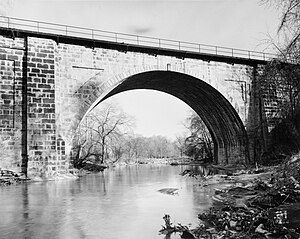Carrollton Viaduct | |
|---|---|
 Carrollton Viaduct over the Gwynns Falls stream in southwest Baltimore, first bridge built 1828–1829 for the Baltimore and Ohio Railroad, founded 1827. Pictured in 1971 | |
| Coordinates | 39°16′31″N 76°39′18″W / 39.2754°N 76.6549°W |
| Carries | Railroad |
| Crosses | Gwynns Falls |
| Locale | Baltimore, Maryland |
| Owner | CSX Transportation |
| Characteristics | |
| Design | Arch bridge |
| Material | Granite |
| Total length | 312 feet (95 m) |
| Height | 65 feet (20 m) |
| Longest span | 80 feet (24 m) |
| Clearance below | 51 feet 9 inches (15.8 m) |
| History | |
| Construction start | 1828 |
| Opened | 1829 |
Carrollton Viaduct | |
| Location | Gwynn's Falls near Carroll Park, Baltimore, Maryland |
| Coordinates | 39°16′31.5″N 76°39′17.6″W / 39.275417°N 76.654889°W |
| Built | 1829 |
| Architect | James Lloyd; Caspar Wever |
| NRHP reference No. | 71001032[1] |
| Significant dates | |
| Added to NRHP | November 11, 1971[1] |
| Designated NHL | November 11, 1971[2] |
| Location | |
 | |
The Carrollton Viaduct, located over the Gwynns Falls stream near Carroll Park in southwest Baltimore, Maryland, is the first stone masonry bridge for railroad use in the United States, built for the Baltimore and Ohio Railroad, founded 1827, and one of the world's oldest railroad bridges still in use for rail traffic. Construction began in 1828 and was completed in 1829. The bridge is named in honor of Charles Carroll of Carrollton (1737–1832), of Maryland, known for being the last surviving signer of the Declaration of Independence, the only Roman Catholic in the Second Continental Congress (1775–1781), and wealthiest man in the Thirteen Colonies of the time of the American Revolutionary War (1775–1783).
In 1982 the viaduct was designated a National Historic Civil Engineering Landmark by the American Society of Civil Engineers.
- ^ a b "National Register Information System". National Register of Historic Places. National Park Service. July 9, 2010.
- ^ "Carrollton Viaduct". National Historic Landmark summary listing. National Park Service. Archived from the original on February 11, 2007. Retrieved October 8, 2007.
